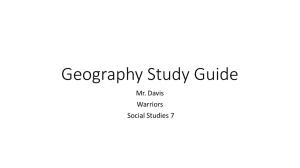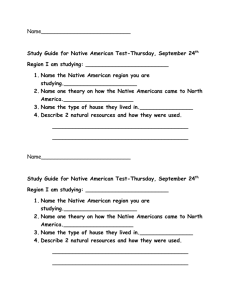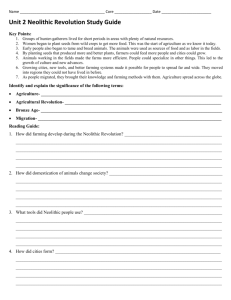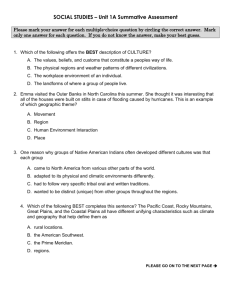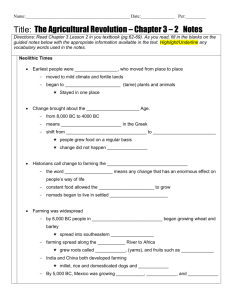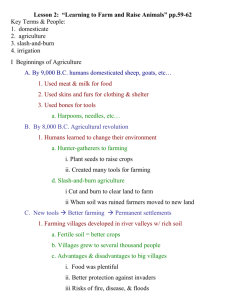Unit 1 Study Guide - Warren County Schools
advertisement
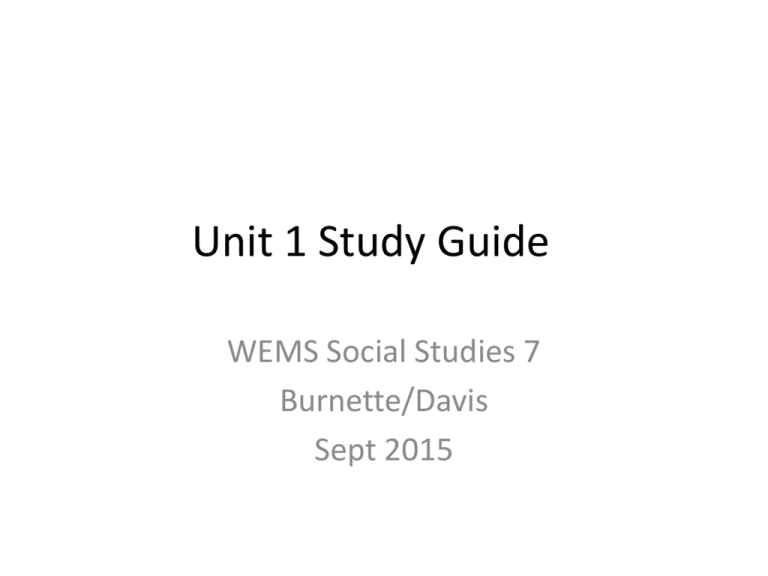
Unit 1 Study Guide WEMS Social Studies 7 Burnette/Davis Sept 2015 1. Give two ways we show absolute location • Coordinates of latitude and longitude (Bowling Green is at 37 N, 86 W) • An address (WEMS is at 7031 Louisville Road) 2. List things a human geographer would be interested in studying • • • • • • Population density Economics Politics Governments Religion Art 3. What are physical characteristics? Give 3 examples • Landforms – the natural way the land is shaped • Mountains • Plains • Valleys 4. Define relative location and give an example • Describing where something is compared to another location. • Examples: “WEMS is next to WEHS.” • “Japan is east of China.” • “My house is down the road from the Corvette Museum.” 5. List things a physical geographer would be interested in studying • • • • Climate patterns Mountain ranges Oceanic trends River valleys 6. How do physical environments affect people’s lives? • It impacts shelters people build • It impacts the clothing people wear • It impacts the crops they produce 7. Why do geographers like Robinson Projection? • It’s most commonly used because it balances the distortions of size and shape to give a fairly accurate projection of the world. 8. Give examples of maps that show elements of human geography • Political maps • Population density maps • Economic activity maps 9. Describe the population density of an urban area • A large number of people living in a very condensed area. The higher the number of people in a given space, the higher the density. 10. What are “push” factors? Give 3 examples • PUSH factors are economic factors that keep people from settling in a region OR cause them to move away (being PUSHED) • War • Disease • Drugs 11. MAP SKILLS! • That pesky South America map from your geography quiz will re-appear. MAKE SURE YOU CAN FIND LOCATION WITH LATITUDE AND LONGITUDE AND USING RELATIVE TERMS! 12. What are some ways landforms can affect people’s lives? • Keeps them isolated so they don’t speak the same language • Influences where people settle • Influences what jobs are available 13. What types of physical features would attract settlement? • A rich mineral deposit • A river valley • Fertile farmland 14. What can you find on a physical map? • Landforms • Mountain ranges • Bodies of water 15. List 3 examples of HumanEnvironment Interaction • Mining for coal • Building neighborhoods • Irrigating a field of crops 16. Describe a political map • It’s a kind of map that shows boundaries of how humans divided the earth into states and/or countries 17. What would a historian be most interested in studying? • The knowledge, beliefs, and customs of a group of people. 18. What would an archaeologist be interested in studying? • Sites of ancient battles where they could find remains or artifacts 19. Define culture • The beliefs, customs, and art of a group 20. What do cave paintings show? • What animals roamed the earth • How people hunted • Hints about early people’s beliefs 21. What are primary and secondary sources? • PRIMARY = something written by somebody who experienced or took part in an event (like a journal) • SECONDARY = information gathered by somebody about a subject (like a textbook or an interpretation) 22. How does studying history improve your thinking skills? • Leads you to ask important questions • Leads you to create hypotheses • Helping you identify main facts/clues 23. What is prehistory? • The term given to the time before written history 24. What is a hominid? • An early ancestor of humans 25. What is the scientific name for modern humans? • Homo sapiens 26. What effect did the invention of tools have on early humans? • They INCREASED the chances for survival 27. What is the earliest skill hominids developed? • The ability to create tools 28. What is a society? • A community of people who share a common culture 29. Why did people make clothes and shelter as they migrated out of Africa? • They needed more protection to survive in colder climates 30. What marked the shift to the Neolithic Age? • Using seeds to grow crops 31. What was the most important result of the Neolithic Revolution? • The change from hunting-gathering to farming 32. What effect did farming have on people in the Stone Age? • It allowed them to build permanent settlements 33. How are farming and the growth of towns related? • The development of farming helped establish permanent settlements.
